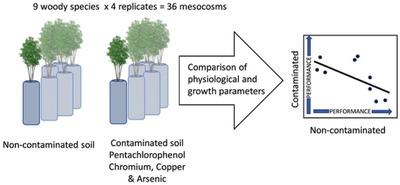当前位置:
X-MOL 学术
›
Clean - Soil Air Water
›
论文详情
Our official English website, www.x-mol.net, welcomes your
feedback! (Note: you will need to create a separate account there.)
Using Native Woody Plants for Phytomanagement of Urban Technosols Contaminated by Wood Pole Preservatives
Clean - Soil Air Water ( IF 1.5 ) Pub Date : 2021-01-15 , DOI: 10.1002/clen.202000262 Philippe Heine 1, 2 , Sara Yavari 1, 2 , Cédric Frenette‐Dussault 1, 2 , Gérald J. Zagury 3 , Jacques Brisson 1, 2 , Michel Labrecque 1, 2
Clean - Soil Air Water ( IF 1.5 ) Pub Date : 2021-01-15 , DOI: 10.1002/clen.202000262 Philippe Heine 1, 2 , Sara Yavari 1, 2 , Cédric Frenette‐Dussault 1, 2 , Gérald J. Zagury 3 , Jacques Brisson 1, 2 , Michel Labrecque 1, 2
Affiliation

|
Technosols are a major component of urban areas with little to no value, but many benefits can be gained by the use of native plants for their ecological reclamation. The aim of this study is to examine the capacity of North American native woody species to establish in and remediate a wood preservative‐contaminated technosol. Nine species are planted in mesocosms containing highly contaminated or non‐contaminated synthetic technosols. Remediation potential and plant physiology parameters (survival, photosynthesis and root growth) are monitored during one growing season. Results show an inverse relation between species performance ranking in the non‐contaminated technosol compared to ranking in contaminated soil. Overall, Salix bebbiana and Sambucus canadensis show good potential for phytomanagement of heterogenous contaminated technosols, offering the best compromise between performance in non‐contaminated and contaminated soils. Most species are able to phytoextract copper (Cu), with Rhus typhina, Alnus crispa, and S. bebbiana showing the highest Cu concentrations in stems. The use of multiple native species for technosol reclamation can be beneficial due to the heterogeneous nature of soil contaminants.
中文翻译:

使用原生木本植物对被木杆防腐剂污染的城市甲酚进行植物管理
甲硝酚是城市地区的主要组成部分,几乎没有价值,但利用本地植物进行生态垦殖可以获得许多好处。这项研究的目的是检验北美本地木本物种建立和修复受木材防腐剂污染的技术醇的能力。9种物种被种植在含有高度污染或未污染的合成技术溶胶的中膜世界中。在一个生长季节中监测修复潜力和植物生理参数(存活率,光合作用和根系生长)。结果表明,与在受污染土壤中的排名相比,在未污染技术溶胶中的物种表现等级之间存在反比关系。总体而言,柳柳和加拿大接骨木表现出对异质污染的技术溶胶进行植物管理的良好潜力,在未污染和污染土壤中的性能之间提供了最佳折衷方案。大多数物种能够提取铜(Cu),其中鼠李(Rhus typhina),Al木(Alnus crispa)和贝氏酵母(S. bebbiana)在茎中显示最高的Cu浓度。由于土壤污染物的异质性,使用多种本地物种进行技术保护性垦殖可能是有益的。
更新日期:2021-03-04
中文翻译:

使用原生木本植物对被木杆防腐剂污染的城市甲酚进行植物管理
甲硝酚是城市地区的主要组成部分,几乎没有价值,但利用本地植物进行生态垦殖可以获得许多好处。这项研究的目的是检验北美本地木本物种建立和修复受木材防腐剂污染的技术醇的能力。9种物种被种植在含有高度污染或未污染的合成技术溶胶的中膜世界中。在一个生长季节中监测修复潜力和植物生理参数(存活率,光合作用和根系生长)。结果表明,与在受污染土壤中的排名相比,在未污染技术溶胶中的物种表现等级之间存在反比关系。总体而言,柳柳和加拿大接骨木表现出对异质污染的技术溶胶进行植物管理的良好潜力,在未污染和污染土壤中的性能之间提供了最佳折衷方案。大多数物种能够提取铜(Cu),其中鼠李(Rhus typhina),Al木(Alnus crispa)和贝氏酵母(S. bebbiana)在茎中显示最高的Cu浓度。由于土壤污染物的异质性,使用多种本地物种进行技术保护性垦殖可能是有益的。











































 京公网安备 11010802027423号
京公网安备 11010802027423号